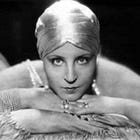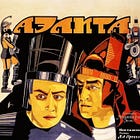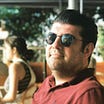Fritz Lang's Second Film: Woman in the Moon
An important film to discuss here is the "Woman in the Moon" (Frau im Mond), another collaboration between Fritz Lang and Thea von Harbou, much like their previous work, Metropolis.
An important film to discuss here is the "Woman in the Moon" (Frau im Mond), another collaboration between Fritz Lang and Thea von Harbou, much like their previous work, Metropolis. Adapted from Harbou's book of the same name, the film premiered on October 15, 1929. Despite our prior experience with moon journeys in George Melies' "A Trip to the Moon," this film introduces the fundamental principles of rocket travel, including rocket fuel, engines, launch procedures, etc., to a broader audience for the first time.
The technological authenticity in the film, particularly in rocket technology and astronaut engineering, can be credited to the guidance of physicist Hermann Oberth. Oberth's contributions allowed the film to be classified under the "scientific" science fiction subgenre. Despite the lack of scientific accuracy in the moon segment (where we observe air, water, and gold on the Earth's satellite), Oberth's involvement made it possible. Intriguingly, this film set the stage for inspiring the German Army's space endeavors, with the "Woman in the Moon" logo placed under the V-2, the first functional liquid-fueled rocket successfully launched on October 3, 1942, from the Peenemünde Army Research Center.
Rather than delving into the extensive narrative of the film, let's examine the purpose of the space adventure, which differs intriguingly from its predecessors. A cartel formed by a few unscrupulous businessmen plans an experimental journey to the moon in the hopes of looting the vast gold reserves found there. Fritz Lang, by extending entrepreneurship beyond Earth with this film, vividly depicts how greed can turn humanity into a monster.
Examining the characters, "Wolf Helius," played by Willy Fritsch, a leading character actor in German expressionist cinema, is an entrepreneur with a keen interest in space travel. Another significant figure is the visionary Professor Mannfeldt (Klaus Pohl), who writes a thesis on the possibility of gold on the moon, despite not being taken seriously by his colleagues. Helius acknowledges the value of Mannfeldt's work, but there's another force interested in Mannfeldt's theories—the nefarious gang of greedy businessmen.
Embarking on a journey to meet Professor Mannfeldt, Helius, led by a group of businessmen headed by "Walter Turner," a pseudonym for an American, is attacked. The gang steals Mannfeldt's research entrusted to Helius and presents him with an ultimatum: either they become part of the moon project or they'll sabotage the journey and destroy the rocket. Helius reluctantly agrees to the ultimatum. The gang leader Walter Turner, Professor Mannfeldt, his assistant Windegger (Gustav von Wangenheim), and the woman he loves, Friede (Gerda Maurus), become part of Helius's team.
The film introduces a romantic triangle as Windegger harbors strong feelings for Friede. With its mix of realistic space travel, espionage, gold reserves, and romance, "Woman on the Moon" foreshadows a complex subgenre of science fiction. Despite the lack of air or gold on the moon, Lang cleverly uses a technique to convince the audience of its existence. Professor Mannfeldt, wearing astronaut suits, lands on the moon's surface and, to prove the presence of air, water, and gold, he takes out a matchbox, lights matches three times, and each time, the flame ignites. He then raises his mineral-searching rod into the air, and a force begins pulling him towards the inside of the moon, with Walter Turner following suit.
The story takes a twist when Professor Mannfeldt, falling down a pit in the gold mine, dies, and Walter Turner is shot and killed by Windegger while attempting to hijack the rocket to return to Earth. A bullet fired during the conflict hits an oxygen tank, leading to the dilemma of someone from Friede, Windegger, Helius, or Gustav having to stay on the moon.
Windegger's inability to control his anger and cowardice during the confrontation, along with Helius's decision not to return to Earth, are the primary reasons for this choice. Additionally, Helius, thinking that Friede has feelings for Windegger, decides to sacrifice himself. Fritz Lang makes a reference to Da Vinci's "The Last Supper," creating an epic "Last Drink" scene. Helius, before their journey back to Earth, offers them a final drink. He extends a glass of wine to each of them, but Friede realizes there's something in her wine and pretends to drink; Windegger, however, drinks, calms down, and falls into a deep sleep. Helius reveals to Gustav, his young companion, that he will stay on the moon and asks him to take the rocket back to Earth. A few minutes after the rocket, piloted by Gustav, takes off, it disappears, and Helius realizes he is left alone on the moon. The young man, terrified, returns to the camp with a downcast neck, concluding the film with a happy ending reflective of the psychology of that era. Friede, remaining on the moon with him, tries to comfort Helius by whispering something in his ear.










